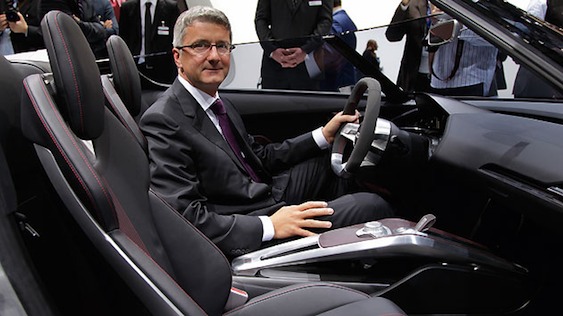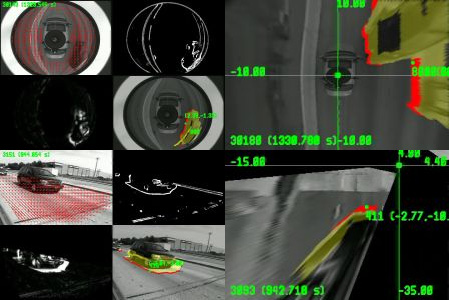UC San Diego Teams with Other Universities and Audi to Help Urban Drivers
New Audi-university partnership will explore how connected cars can solve urban mobility challenges
San Diego, January 20, 2011 -- A new research initiative launched by Audi, its Electronics Research Laboratory in Silicon Valley, the University of California, San Diego and three other major U.S. research universities will develop technologies aimed at easing the congestion, dangers and inconveniences that often confront drivers in the world's biggest cities.
|
“Technologies that help motorists become more aware and efficient are a crucial step toward solving some of the biggest transportation challenges on the horizon across the world,” said Dr. Burkhard Huhnke, executive director of the Audi Electronics Research Laboratory in Palo Alto, Calif. “Audi is confident that this initiative will provide an important insight on the future of urban transportation and produce innovative concepts that promote efficient, pleasant, and safer mobility.”
“Safety on urban roads will require a very deep understanding of the driver and his or her environment,” added UC San Diego electrical and computer engineering professor Mohan Trivedi, director of the university’s Laboratory for Intelligent and Safe Automobiles (LISA). “With the proliferation of consumer electronics devices in and on-board vehicles, a major challenge in front of us is to ensure that assistance systems really help rather than distract or irritate the driver."
|
The Audi Urban Intelligent Assist project is the latest in a series of high-profile university collaborations that Audi has formed to explore the frontiers of automotive technologies and electronics. By working closely with the brightest electronics minds in the U.S., Audi and ERL are bringing to life the strategy expressed by AUDI AG Chairman Rupert Stadler in his Jan. 6 keynote address to the Consumer Electronics Show.
“Our plan is to integrate the best technologies from the best partners available and adapt these for the automotive world,” Stadler said. “And we intend to pick up the pace of innovation even further.”
Other Audi initiatives with ERL have explored advances in autonomous driving, emissions controls and monitoring, and dynamic navigation systems that connect to a driver’s life patterns and social circle. University partners in the previous research efforts have included Stanford, MIT and UC Riverside.
|
Cities in the United States and the world are growing at a rapid pace. In the U.S., urban population has exploded to about 85 percent of the country’s total. This translates into expanding but denser cities and megacities. Given the difficulties and high cost of updating the urban infrastructure, these factors pose a real mobility challenge today and for the future.
Increased road congestion, longer commute times and insufficient infrastructure to house the rapidly expanding vehicular pool, is making driving in megacities an increasingly stressful and dangerous task, which impacts the quality of life of every commuter.
Audi is aware of these future mobility challenges, and of the opportunities that an increasingly connected world brings for the future. In order to advance the development of urban mobility, Audi together with ERL embraced the vision of a future involving connected intelligent vehicles that interact with their environment and with each other, to make urban mobility more efficient, more convenient, less stressful, and safer.
After an open request for proposals to American universities, and a lengthy selection process, Audi signed an agreement with the four research universities, each with expertise to pursue the following:
- Audi Driver Diagnostics: Researchers in UCSD’s Laboratory for Intelligent and Safe Automobiles (LISA) will focus on understanding the driver and his/her preferences, to tailor the urban driving experience to fit the personal needs of each Audi customer. The major research questions will address which aspects of urban mobility distract and stress individual motorists, and what kind of metrics can be used, in order to support and assist each user appropriately and to make urban commutes safer, smarter, more enjoyable and more efficient. According to LISA director Mohan Trivedi, who is also affiliated with the California Institute for Telecommunications and Information Technology (Calit2), UCSD will build on its unique expertise in the development of holistic multimodal systems for situational criticality and driver intention prediction. “Our team will explore novel machine learning and vision systems to analyze what is happening around the vehicle,” he said. “This is a particularly difficult task in urban environs where cyclists and pedestrians contribute to the visual clutter.”
- Audi Urban Assistance: UC San Diego, along with USC and UC Berkeley PATH, will deal with finding the correct way to bring relevant urban information to the driver, minimizing distraction, information overload, and stress. The research focus is on determining critical information in urban situations, such as vehicle and pedestrian detection for intersection safety, available parking spaces near a destination, or the governing traffic rules at the time of arrival (no parking, car pool lanes, no left turn, etc.). The systems would then find the correct medium to convey this information to the driver.
- Audi Urban Crash Analysis: UMTRI will conduct a study using extensive accident databases with the aim of finding “accident hot spots” in urban centers. The idea is to understand what scenarios in urban driving environments pose the higher threats and difficulties for drivers, leading to a higher number of accidents. Understanding the circumstances and scenarios of accidents, it is possible to determine likely causes, and this information will be important for the design of systems to mitigate or eliminate these threats in the connected Audi of the future.
- Audi Urban Diagnostics: UC Berkeley PATH will be focused on getting and aggregating historic and real time urban data from multiple sources, to support the overall goal of the Urban Intelligent Assist initiative. This data will include traffic and traffic controlling information (i.e. traffic lights, etc.), parking availability, urban events (sports events, concerts, accidents, etc.) among other, in order to get an up-to-the-minute snapshot of the city, but also to make predictions on what the city is going to look like in the near future (15 to 60 minutes from now).
- Audi Urban Navigation: USC will use urban information collected from multiple on and off board sources to predict how the city flows through the day, and use this in combination to the driver diagnostic information to generate the most comfortable and efficient route for each driver, and to give recommendations about route planning and execution tailor made to each user to make each trip a smart and stress-free one.
About Audi
Audi of America, Inc. and its 272 U.S. dealers offer a full line of German-engineered luxury vehicles. AUDI AG is among the most successful luxury automotive brands globally. During 2009 Audi outsold all other luxury brands in Europe, while in the U.S. market Audi posted the largest market share gain of any luxury automotive brand. Between 2010 and 2012 the Audi Group is planning to invest around €5.5 billion, mainly in new products, in order to sustain the Company’s technological lead. Visit www.audiusa.com or www.audiusanews.com for more information regarding Audi vehicle and business issues.
About ERL
The Electronics Research Laboratory (ERL) in Palo Alto, California, is a high-tech think-tank that has been developing new technologies for Audi cars and other brands within the Volkswagen Group since 1998. The ERL focuses on accelerating automotive innovation for future production vehicles. Positioned in the heart of Silicon Valley, the ERL works closely with many of the world's leading high-tech companies, start-ups, and universities. Information regarding the ERL can be found at http://www.vwerl.com/.
About LISA
The Laboratory for Intelligent, Safe Automobiles (LISA) at the University of California, San Diego is a multidisciplinary effort to explore innovative approaches to making future automobiles safer and more “intelligent”. This is accomplished by research in computer vision and intelligent systems with synergistic contributions from cognitive science, psychology and decision theory. LISA includes a broad theoretical as well as experimental research agenda, including testbed vehicles, real-time machine vision systems, multimodal interfaces and driving simulators. http://cvrr.ucsd.edu/lisa/
Related Links
Laboratory for Intelligent and Safe Automobiles
UCSD Computer Vision and Robotics Research Lab
Audi USA
Audi News
Electronics Research Laboratory
Media Contacts
Doug Ramsey, Calit2 UCSD, 858-822-5825, dramsey@ucsd.edu or Brad Stertz, Audi of America, 703-364-7440



